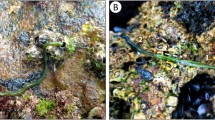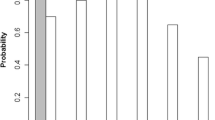Abstract
Predatory larvae of the midge Chaoborus americanus induce an antipredator defense (‘neckteeth’) in prey individuals of the cladoceran Daphnia pulex. The signal for presence of predator is a water-soluble chemical. We provide evidence that this kairomone originates in the intestinal tract of the predator. The active compound is an organic molecule of intermediate polarity which is heat stable and partially destroyed by acid and base digestion. It is stable to digestion by the general peptidase Pronase. Hydroxyl groups, but not primary amines, carbonyls or thiols are essential to activity. Low-pressure liquid chromatography on a reverse-phase silica gel (Amicon Matrex C-18) column suggests there may be more than one active component.
Similar content being viewed by others
References
Baumgarten, H. E., ed. 1973. Organic Syntheses, Vol. 5, John Wiley & Sons, NY, NY, p. 791.
Castell, J. V., M. Cervena & R. Marco, 1979. A convenient micromethod for the assay of primary amines and proteins with fluorescamine. A reexamination of the conditions of reaction. Analyt. Biochem. 99: 379–391.
Crowder, L. B., R. W. Drenner, W. C. Kerfoot, D. J. McQueen, E. L. Mills, U. Sommer, C. N. Spencer & M. J. Vanni, 1988. Food web interactions in lakes. In Complex Interactions in Lake Communities, Carpenter, S.R. (ed.) Springer-Verlag, New York, NY: 141–160.
Dyer, J. R., 1956. Use of periodate oxidations in biochemical analyses, pp. 111–152 in Methods of Biochem. Anal. Vol. 3, Glick, D., ed., Interscience Publ., NY, NY.
Fieser, L. F. & M. Fieser, 1967. Reagents for Organic Syntheses. Vol. I, John Wiley & Sons, NY, NY.
Fieser, L. F. & M. Fieser, 1984. Reagents for Organic Syntheses. Vol. II.
Gilbert, J. J., 1966. Rotifer ecology and embryological induction. Science 151: 1234–1237.
Gottschalk, W. K. & D. R. Sonneborn, 1985. Evidence that Blastocladiella emersonii zoospore maintenance factor is an SH-containing cyclic ribotide. JBC 260: 6592–6599.
Grant, J. W. G. & I. A. E. Bayley, 1981. Predator induction of crests in morphs of the Daphnia carinata King complex. Limnol. Oceanogr. 26: 201–218.
Harvell, C. D., 1984. Predator-induced defense in a marine bryozoan. Science 224: 1357–1359.
Havel, J. E., 1985. Cyclomorphosis of Daphnia pulex spined morph. Limnol. Oceanogr. 30: 853–861.
Havel, J. E., 1987. Predator-induced defenses: a review. In Kerfoot, W. C. & A. Sih (eds.) Predation: Direct and Indirect Impacts on Aquatic Communities. Univ. Press of New England, Hanover, N.H.: 263–278.
Havel, J. E. & S. I. Dodson, 1984. Chaoborus predation on typical and spined morphs of Daphnia pulex: Behavioral observations. Limnol. Oceanogr. 29: 487–494.
Havel, J. E. & S. I. Dodson, 1987. Reproductive costs of Chaoborus-induced polymorphism in Daphnia pulex. Hydrobiologia 150: 273–281.
Hebert, P. D. N. & P. M. Grewe, 1985. Chaoborus induced shifts in the morphology of Daphnia ambigua. Limnol. Oceanogr. 30: 1291–1297.
Hebert, P. D. N., R. D. Ward & L. J. Weider, 1988. Clonal-diversity patterns and breeding-system variation in Daphnia pulex, and asexual-sexual complex. Evolution 42: 147–059.
Kaiser, G., 1984. Beutefang und Verdauung bei der Larve der Buschelmucke Chaoborus plumicornis. Microkosmos 73 (9): 262–269.
Kay, R. R., B. Dhokia & K. A. Jermyn, 1983. Purification of stalk-cell-inducing morphogens from Dictyostelium discoideium. Europ. J. Biochem. 136: 51–56.
Kerfoot, W. C., 1977. Competition in cladoceran communities: The cost of evolving defenses against copepod predation. Ecology 58: 303–313.
Kerfoot, W. C. & A. Sih, 1987. Predation: Direct and Indirect Impacts on Aquatic Communities. Univ. Press of New England, Hanover, N.H.
Knapp, D. R., 1979. Handbook of Analytical Derivitization Reactions, John Wiley & Sons, NY, NY.
Krueger, D. A. & S. I. Dodson, 1981. Embryological induction and predation ecology in Daphnia pulex. Limnol. Oceanogr. 26: 219–223.
Martin, B. R., 1987. Metabolic Regulation: A Molecular Approach. Blackwell Sci. Publ., Oxford. pp. 31–32.
Narahasi, Y., 1970. Pronase, in Methods in Enzymology 19: 651–664.
Obreshkove, V. & A. W. Fraser, 1940. Growth and differentiation of Daphnia magna eggs in vitro. Biol. Bull. 78: 426–436.
Stryer, L., 1981. Biochemistry. W. H. Freeman & Co., San Francisco, p. 115.
Threlkeld, S. T., 1979. Estimating cladoceran birth rates: the importance of egg mortality and the egg age distribution. Limnol. Oceanogr. 24: 601–612.
Walls, M. & M. Ketola, 1989. Effects of predator-induced spines on individual fitness in Daphnia pulex. Limnol. Oceanogr. 34: 390–396.
Washburne, J. O., M. E. Gross, D. R. Mercer & J. R. Anderson, 1988. Predator-induced trophic shift of a free-living ciliate: Parasitism of mosquito larvae by their prey. Science 240: 1193–1195.
Author information
Authors and Affiliations
Rights and permissions
About this article
Cite this article
Parejko, K., Dodson, S. Progress towards characterization of a predator/prey kairomone: Daphnia pulex and Chaoborus americanus . Hydrobiologia 198, 51–59 (1990). https://doi.org/10.1007/BF00048622
Issue Date:
DOI: https://doi.org/10.1007/BF00048622




